













Over the last 20 years, the Housing Executive, as the strategic housing authority for Northern Ireland, has held the responsibility for securing the provision of housing-related support services and the administrative responsibility for delivering the Supporting People Programme.
The purpose of the programme is to offer vulnerable people the opportunity to improve their quality of life, by supporting and enabling them to live more independently.
Supporting People plays a crucial role, not only in the housing and the health and social care sectors, but across communities in Northern Ireland.

It provides vital ongoing support to vulnerable households across Northern Ireland.
As we celebrate the successes of Supporting People, the measure of success comes from the real improvements to the lives of many people and how they have benefitted from invaluable support at some of the most challenging times in their lives.
To date, the Supporting People Programme has invested over £1.2 billion. Last year over £76 million was distributed to 82 service providers who deliver over 800 vital services to over 19,000 individuals across Northern Ireland.
Established in April 2003, the programme is delivered in partnership with Health and Social Care and the Department of Justice, on behalf of the Department for Communities. Grant funding is paid to partner organisations to enable them to deliver services that provide housing-related support and assistance to service users, enabling them to live as independently as possible in the community.
The Supporting People Programme in Northern Ireland has three broad objectives:

• achieve a better quality of life for vulnerable people to live more independently and maintain their tenancies;
• provide housing support services to prevent problems that can often lead to hospitalisation, institutional care, or homelessness; and
• help to smooth the transition to independent living for those leaving an institutionalised environment.
The programme is focused on four thematic areas; supporting people who are experiencing homelessness; young people; older people; and people with a disability, including mental health and learning disabilities. Over 19,000 people are supported to live independently each year.
The programme has a broad provider base with organisations spanning across the public, private, community and voluntary sectors, delivering;
• short-term accommodation and support for people in housing need (hostels, refuges and foyers);
• long-term accommodation and support to sustain a home (supported accommodation);
• floating support delivered into people’s homes for a short period of time (up to two years) to maintain or regain independent living; and
• longer term peripatetic/dispersed support delivered into people’s homes to maintain independent living for people with more enduring needs.
The core functions of housing related support include:
• promoting housing stability and ensuring security of tenure;
• ensure income is maximised, to meet housing and other costs;
• ensure access to health and social care and specialist services;
• training and support with daily living skills;
• encouragement and support of positive friendships and family relationships; and
• encouragement and support of positive community links and participation.
Housing support services funded through the programme are often provided alongside a range of measures from other agencies as part of a continuum of services.
The Supporting People Programme not only provides assistance for vulnerable people to live independently in their own home, it also reduces other costs to the public purse. A report commissioned by NICVA in 2015* estimated that every £1 spent on the Supporting People services saves the public purse £1.90. The Housing Executive also commissioned research in 2020 on the ‘Social Return on Investment’ and the findings indicated that every £1 spent on Supporting People between 2018 and 2021 generated a social value of £1: £5.71.
The preventative value of the Supporting People Programme, relieving financial pressure on the wider public sector, cannot be overemphasised.
In 2022, the Housing Executive introduced the Supporting People Strategic Plan and Covid-19 Recovery Plan 2022-2025 which focuses on driving recovery and re-build beyond Covid-19, working towards closing the 14 per cent gap between need for services and supply, collaborating with providers to invest in service innovation to achieve greater outcomes and strengthening relationships across health, criminal justice and housing with the aim of generating greater value from public funds.
The new plan can be found online at nihe.gov.uk and searching Supporting People.
Developed following extensive engagement with stakeholders including service users from the voluntary, community, and statutory sectors, we look forward to continue working with all our partners.
To mark the 20th Anniversary of the Supporting People Programme in Northern Ireland, the Housing Executive is organising a series of activities and
events to highlight and promote the impact, benefits and positive outcomes for service users throughout the 20 years of the programme. This includes the production of a film documenting the work of Supporting People, provider organisations and the impact the programme has had on the lives of those supported.
The film will premiere at an event in the Parliament Buildings, Stormont, in June 2023 and will be made available through the Housing Executive’s social media channels. During the event partners, providers and staff will gather to celebrate the success and impact of the programme over the last two decades. Speakers will highlight the significance and impact of the programme as well as its future priorities.
The collaboration between the Housing Executive, the Department for Communities, the Department of Health and the Department of Justice has been a productive joined-up approach in the successful delivery of the Supporting People Programme over the past two decades.
We also thank Supporting People staff who administer the programme and the invaluable contribution of service provider staff who have made, and continue to make, a remarkable and positive difference to the lives of so many people.
For further information about Supporting People, please contact:
The Housing Centre
2 Adelaide Street
Belfast, BT2 8PB
T: 0344 892 0900
W: www.nihe.gov.uk
*Centre for Economic Empowerment (2015) The Financial Benefits of the Supporting People Programme in Northern Ireland, Northern Ireland: NICVA


Hosford House is a homeless project of East Belfast Mission providing support and shelter for the last 20 years. It is a 26-bed hostel for single men and women. Accommodation involves several different options (including move on apartments) depending on the needs of the clients. Clients are helped towards a goal of moving to independent accommodation with access to extensive support to help tackle and deal with the problems they encounter.
Supporting People also fund East Belfast Mission to provide the Hosford Tenancy Support Service which provides floating support to help people maintain their tenancies and avoid homelessness through regular one-toone support to people who are at risk of homelessness.
Camphill Clanabogan works to create communities in which adults, many with learning difficulties, can live, learn and work with others in healthy social relationships. There are over 80 people in Clanabogan, of which 30 units of support funded through Supporting People.
Baking, weaving, ceramics, woodwork and other handicrafts are developed in workshops where groups of people learn to work sociably and creatively. People are also supported to express themselves creatively through crafts, music and drama.
Members of multi-disciplinary teams including podiatry, GPs, community nurses, speech and language, and occupational therapy carry out visits to the service. This provides a holistic approach to community life within Clanabogan.

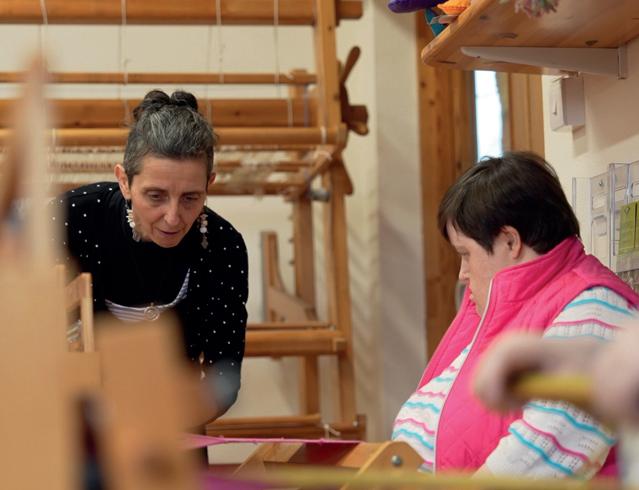
Belfast Central Mission Supported Housing for Young People, Tafelta Rise, Magherafelt provides 13 self-contained apartments for young people from 16 to 21 years. Accommodation is available for up to two years and referrals are accepted from the Housing Executive and NH&SCT. Four of the units are available for young people under 18 years of age.
The project aims to support vulnerable young people to develop the skills to live independently in the community.
Belfast Central Mission Supported Housing aims to work in partnership with each young person and to offer them the opportunity to experience a gradual transition from residential, family or foster care to independent living in the community.
Donard Fold offers 25 units of apartment style accommodation specially designed for over 55s who want to live independently with the reassurance of 24 hour support.
Independent living apartments offer the opportunity to take full advantage of the communal areas and designated tenant gardens with the added comfort of a safe and secure living environment.
Independent living tenants have the choice to take part in a wide range of social activities, events, and outings.


The Climate Change Commission (CCC) states that buildings in Northern Ireland will need to decarbonise by 33 per cent overall by 2030 from 2020 levels.
The CCC’s advice report, The Path to a Net Zero Northern Ireland, notes that the 24 per cent decrease seen in emissions since in 1990 “comes largely from a fall in buildings emissions in the early 1990s”, as well as other sectors in the 2000s, but also notes that buildings emissions are up 1 per cent since 2009. To be on track for the CCC’s ‘stretch ambition’, which would see Northern Ireland decarbonise by 93 per cent overall rather than the legally binding 100 per cent, emissions from the buildings sector – which accounted for 3MtCO2e in 2020 – would need to fall by 33 per cent from 2020 to 2030.
While the buildings sector is not solely made up of homes, the advice report also states that by 2030 for all homes off-gas grid and 2033 for all homes on-gas grid, all new heating appliance installations should be zero carbon if the 33 per cent and 93 per cent reductions for 2030 and 2050 respectively are to be met. Under the CCC’s balanced pathway, which would reach 83 per cent decarbonisation overall by 2050, it is recommended that the rate of residential buildings decarbonisation be slowed down to match the UK Tailwinds pathway. Buildings emissions in Northern Ireland were found to fall much faster than in England due to the disparity in homes off-gas grid (circa 65 per cent in Northern Ireland compared to 12 per cent in England), but the CCC warns that “scaling up low-carbon heat so quickly in Northern Ireland could have issues with local workforce skills and supply chains”.
In November 2022, the Housing Executive published its intentions on decarbonising its housing stock, with a retrofit programme to increase energy efficiency by 2030 and a 23 per cent reduction in carbon emissions up to 2030/31 targeted.
As Northern Ireland’s first carbon budget period has already begun, the CCC notes that a step change “must begin immediately”. For the buildings sector, this entails “concerted action” such as the rendering of all newly constructed homes as zero-carbon “as soon as possible”, with no later requirement for retrofit. The CCC states that the achievement of new heating appliances being zero-carbon for offgas grid homes by 2030 and 2033 for on-gas grid homes would necessitate the “necessary strengthening of electricity networks”. Such moves would have massive implications for wider infrastructure and be “unlikely to be compatible with further extension to the Northern Ireland gas network”.

Deputy Secretary of Housing, Urban Regeneration and Local Government at the Department for Communities, Mark O'Donnell, discusses progress on the draft Housing Supply Strategy, expansion of the Social Housing Development Programme, and the challenge of net zero.
The draft Housing Supply Strategy was formed in the context of recognisable challenges in the form of increased housing stress, homelessness, and affordability challenges for both renters and potential owners. Two-and-a-half years after publication, the Strategy has still not received Executive approval and O’Donnell believes that those

original challenges have become even more pronounced.
“Demand has not reduced. It seems fewer households are able to access homeownership, perhaps due to higher mortgage rates, higher property prices, economic uncertainty, or the cost-ofliving crisis,” he says.

Housing
Need & Demand Drivers
Supporting People
Shaping Places
Building Communities
Housing Supply Levers
“At the same time, social housing allocations are not where we would want them to be. There is competition for homes.”
The publication of the final Housing Supply Strategy has been delayed due to the lack of a functioning Executive, and while O’Donnell says he cannot pretend there are no consequences to not having a government in place, the extensive engagement process and broad consensus on the core aspects of the strategy has provided confidence to move forward with the development of a first action plan, ensuring work towards implementation is already underway.
Early identified draft actions include providing more social and intermediate homes, including the development of a new intermediate rent product; implementation of the Social Housing Allocations review, and progression of regulations to improve the private rented sector.
O’Donnell stresses that while most of the initial actions fall under the remit of the Department, the “whole system approach” to developing the draft Strategy has helped to forge relationships with stakeholders.
“For example, we have been actively working with other departments and stakeholders to identify and progress actions that will help us deliver on major cross-cutting issues such as skills and infrastructure,” he explains.
“This includes work underway to ensure
wastewater data is being effectively shared and used between relevant bodies. Also, developing actions to upskill and re-skill our existing workforce and making the construction sector an attractive proposition for young people.”
O’Donnell emphasises that the provision of new social homes remains a priority for his department, pointing out that despite other financial pressures, the majority of the Department’s capital budget is spent on the delivery of new social homes.
The Deputy Secretary explains that aspirations to increase new social housing targets are not only driven by the current waiting lists, but also the growing number of people seeking asylum and evacuees arriving in Northern Ireland in the past year.
“The good will of the public and the voluntary sector have mobilised impressively to meet this challenge, but it all represents strain on our capacity to provide temporary accommodation. This in turn reflects strain on our capacity to provide permanent and appropriate solutions through social housing. The strategic solution is always more social housing.”
Currently, there are two main limiting factors to delivery. The first is budget. The Department estimates the need for at least 33,000 new social homes over the next 15 years, however, recent
The


analysis shows that if the Department was to increase starts by 50 units per year for the next five years, the cost would be well over £1 billion.
“The budget outlook at the moment is therefore pretty worrying,” states O’Donnell.
The second factor is the capacity to deliver. The Deputy Secretary stresses that the challenges of budget and capacity are interlinked, highlighting that extra funds will only be made available if decision-makers have confidence in the Department’s capacity to spend its allocation.
On plans to increase the Social Housing Development Programme (SHDP), O’Donnell says, “We have been working closely with the Housing Executive, housing associations, and a range of public bodies to identify what actions we need to take and how we might better structure delivery. Real change can only be achieved through genuine cross-departmental and appropriate government commitment to tackle housing need.”
The Deputy Secretary indicates that work is ongoing to identify public land held by government departments which could be released for social housing, while at the same time identifying the potential acquisition of existing
properties, to increase social housing stock.
Discussing additional challenges in relation to wastewater infrastructure and subsequent planning restrictions, O’Donnell says the Department is working with its counterparts in the Department for Infrastructure (DfI) to find solutions and prioritise planning for housing in key areas of social housing need.
Turning to the other significant challenge shaping the work of the Department and delivery of the Housing Supply Strategy, O’Donnell says that some of the most significant challenges for his department in relation to climate change are directly related to the residential sector.
The Department for Communities is leading the residential element of the buildings sector emission reduction targets. Currently, residential dwellings account for 14 per cent of Northern Ireland’s greenhouse gas emissions, but a step change is required if a targeted 33 per cent reduction in the residential sector is to be achieved by 2030.
Highlighting that his department has recently established a new Climate
Change Division to develop policies and actions needed to reduce residential emissions, O’Donnell says that beyond the challenge of a switch away from fossil fuel-based heat systems, there is a need to massively increase the energy efficiency of homes across all residential tenures.
He adds: “We will have to do it carefully to avoid cold bridging, condensation, damp, and mould. And importantly, capacity and skills in our construction sector will need to be enhanced to deliver this.”
The Deputy Secretary believes that, although challenging, the transition to carbon neutrality presents major opportunity for the residential sector, not least the chance to make fundamental change in its ambitions, processes, and social contribution.
“The key role that both the construction of new housing and the retrofitting of existing homes will play in helping to achieve this transition cannot be understated,” he explains.
“Our social housing programme offers the opportunity to lead the way in showing how housing can meet our climate challenges. The Department intends to be proactive in driving the changes necessary to meet our commitments.”
The Housing Executive’s report on the cost of carbon savings in Northern Ireland’s housing stock indicates a mean cost of £15,600 per dwelling to improve energy efficiency to at least EER band B. With approximately 586,000 eligible dwellings, the total cost would be £9.2 billion.
O’Donnell says that a major part of the policy work will, therefore, be to consider how this transition is funded.
The Deputy Secretary concludes by saying: “We also need to consider climate adaptation for houses which means designing homes to be resilient to future changes in climate – like higher temperatures and more extreme weather causing more flooding.
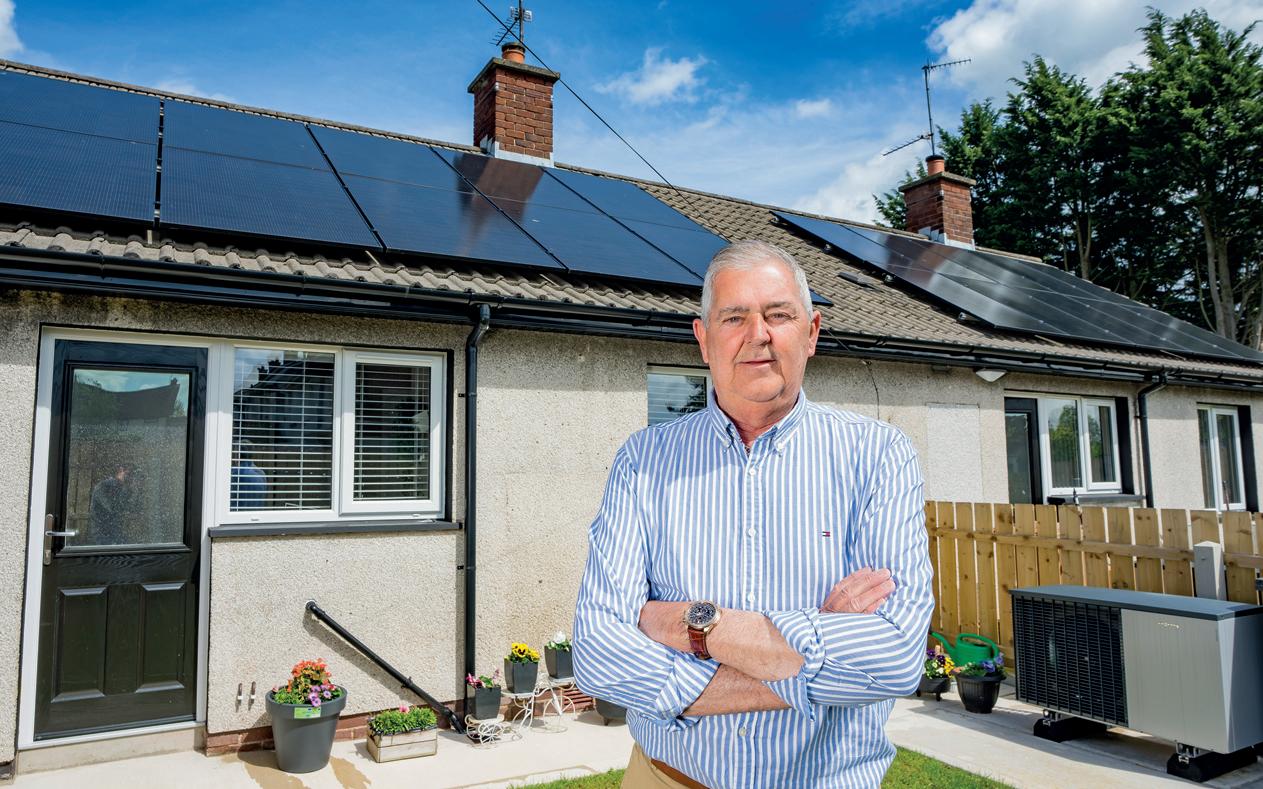
As a housing association, one of Arbour Housing’s key strategic objectives is to provide high-quality homes that meet the long-term needs of our tenants, while delivering on our commitment to net zero. Sustainability and decarbonisation are important elements of that objective.
With that in mind, we undertook a substantial retrofit of two semi-detached bungalows in Fort Street, Banbridge, replacing the old oil-fired central heating systems with outdoor 6kW air source heat pumps connected to an indoor compressor unit and hot water tank. The work was part-funded by the Department for Communities.
The two homes were vacant before the new system and other elements were
installed. This allowed for the works, which included laying underfloor heating throughout, to be carried out without inconveniencing sitting tenants.
In addition to the air source heat pumps, both of the properties have benefited from new cavity wall, floor, and roofspace insulation, and have had solar panels installed. In due course, these will provide a renewable source of electricity to power the air pumps.
Both properties are now occupied, with tenants receiving one-to-one training on the system controls and room settings at the start of their tenancies. Five months after he moved in, we caught up with one tenant, George Gallagher, and asked how he found living with the new system.
“The heat pump is quieter and cheaper to run than my previous gas heating system,” he explains. “The air quality has improved too, with less moisture in my new home. I am not even that aware of the system now. I keep it at a steady temperature and do not need to use the hourly boost button. The heat pump itself is very compact and does not take up much room in the back garden.”
So, what is the best part of living with the air source heat pump system?
“It is great having extra space without radiators. I can walk around in my socks with my feet toasty warm in every room,” boasts Gallagher.
The system generates real-time data via room sensors and other monitoring equipment. In addition to collecting this information ourselves, we are sharing it with the Department for the Economy. Collection of the data is done remotely (although the tenant also tracks his own consumption on a weekly spreadsheet), which allows us to diagnose any system faults and, crucially, identify opportunities to improve efficiency and optimise the system for future roll-out.
Stephen Hunter, Compliance and Sustainability Officer
T: 028 38 339 795
E: stephen@arbourhousing.org
W: www.arbourhousing.org



A new affordable housing policy aimed at longer-term rents at least 20 per cent below market value has been geared at increasing housing supply.
The Intermediate Rent Policy, published by the Department for Communities, is tailored towards those earning above the social housing affordability threshold but struggling to access the private rented sector.
Published over two years ago, the draft Housing Supply Strategy set out ambitions to introduce a range of measures to increase the supply of affordable housing. While no Executive has been in place to approve the strategy, significant consultation on it prior to the Executive’s collapse has enabled the Department for Communities to progress some policies, including the Intermediate Rent Policy.
The Intermediate Rent Policy was published and came in to operation on 30 March 2023.
Intermediate rent is neither social housing nor open market private rental. Instead, the model recognises that increased social housing supply alone will not be adequate to address levels
of unmet housing need in Northern Ireland.
Research done by the UK Collaborative Centre for Housing Evidence for the Department for Communities suggests that Northern Ireland has around 135,000 privately renting households, over a third of whom pay 25 per cent or more of their income in rent. Over 14 per cent of private renters are estimated to be paying 40 per cent or more of their income.
Alongside affordability, security of tenure has been a long-term concern for those in the private rental sector. The Private Tenancies Act (Northern Ireland) 2022 sought to strengthen the rights of tenants in the private rented sector. However, some have argued that an increased onus on landlords does not go far enough.
The Intermediate Rent Policy aims to go some way to addressing both affordability and tenure security, with rents offered at least 20 per cent below prevailing market rents for a similar
property type and size within a locality, and tenancies of up to five years at a time, with the option to renew subject to the agreement of the landlord and tenant.
However, the Department has not stipulated how many additional homes it hopes the policy might generate, instead stating that “detail on the number and location of a first phase of intermediate rent homes remains under development”.
Intermediate rent tenancies will still be private rented tenancies but will differ from open market private tenancies in a number of ways, making it a more suitable option for households who can pay more than social rents, but have affordability issues in the open market.
Importantly, the policy is clear that existing occupied dwellings should not be repurposed as intermediate rent.
While it is not intended that tenants have a lifelong tenancy, the policy sets out that intermediate rent homes are intended to remain as such, with a
minimum period of 10 years (two consecutive tenancies). There will also be no option to purchase the property at the end of a tenancy.
Although no funding arrangements have yet been produced, the Department says that it intends to separately provide financial support towards the development and letting of intermediate rent homes, however, in recognising that demand may outstrip supply, the Department has welcomed the development of intermediate rent homes outside of the suggested funding model. Interestingly, the Department states that it will not compel any organisation to deliver intermediate rent.
In a statement, the Department says: “The Department for Communities intends to separately provide financial support towards the development and letting of intermediate rent homes. Work continues to finalise these future funding arrangements. Funding is expected to be made available to an intermediate rent operator who will deliver and let a supply of intermediate rent homes and be awarded funding via a competitive process. The Department will continue to engage with those interested in delivering intermediate rent homes in preparation for awarding funding.
“Subject to budget and approvals, financial assistance in the form of Financial Transactions Capital loan is expected to be made available, alongside a promoter’s contribution, to create a new supply of intermediate rent homes in the future. The Department also welcomes self-funded intermediate rent housing provision.”
The location of intermediate rent homes is not limited, however, it is recognised that the policy may be most effective in areas of high rents and high demand. Alongside the policy, the Department also published a Homes for Intermediate Rent: Design Standards guide, setting out the expected design and finish standards associated with intermediate rent homes.
Single adult applicants for intermediate rent must have an income not exceeding £30,000, rising to a £40,000 ceiling for a two or more adult households, however, it is stated that these homes are not intended to be houses in multiple occupation. The income calculation omits savings up to £30,000, recognising that some tenants may be saving for homeownership, and disability-related benefits, while excluded from a tenant’s income total, can be considered in an ability-to-pay rent assessment.
Northern Ireland
Belfast
Initial rent rates of 20 per cent below market value, which cannot change in the first year, if uprated, must remain not more than 80 per cent of market rents for similar properties in the location.
An assessment by the Department states that in line with the policy that a household should not pay more than 30 per cent of their net income on rent, initial intermediate rent rates would be capped at £750 per month for a single adult household and £1,000 per month for a two or more adult household. However, a household may pay up to 40 per cent of their income in “exceptional” and assessed circumstances.
A number of protections for renters of this mode include rent increase, of no more than 5 per cent per year (while still within the 80 per cent of market values range), a nine-month lead in time to tenancy end/renewal, longer term deposit (six to 12 months) payment periods, and provision for prompt and effective repairs by landlords.
On how delivery of the policy will be funded in the absence of a minister, a spokesperson for the Department for Communities said: “Work continues to deliver a funding package which can support the practical delivery of a supply of new intermediate rent homes in the near future.”

Apex Housing Association (Apex) has launched its 2023-26 corporate strategy.
Apex recently launched its corporate strategy 2023-26 More than Housing at a staff conference hosted by Wendy Austin, with more than 150 members of the team in attendance. ‘More than Housing’ was the focus of the event, with the name of the new strategy having been chosen by Apex’s Tenant Network.
Alongside the launch of the strategy, the event shone a light on the unbelievable work of staff over the last three years through presentations and videos. Many going above and beyond for tenants, residents, and communities in what were unprecedented times as a result of the global pandemic.
Reflecting on the challenges faced, Apex acknowledged the success of Skeoge, which is an area of Derry~Londonderry that has seen the development of over 1,000 Apex homes, 570 of which have been handed over to new tenants in the last three years. Through meaningful engagement with local people, Apex has also been successful in building vital
community support in the area, working with Greater Shantallow Area Partnership.
The event also recognised Apex’s contribution to the Department for Communities and Northern Ireland Housing Executive’s Housing for All Shared Housing Programme, which reflects the Executive’s commitment to improving community relations and continuing the journey towards a more united and shared society. Apex is proud to have 11 shared housing neighbourhoods across Northern Ireland and will deliver another 137 new homes across four new neighbourhoods during the next three years.
Finally, there is no understating the challenge that faced the Apex teams tasked with delivering supported living services 24/7 during the pandemic. The event acknowledged the strength, resilience, and compassion of those involved in supporting more than 1,200 tenants and residents during a period that imposed unprecedented restrictions.
Looking ahead there are significant challenges including the lack of a functioning Northern Ireland Executive, inadequate funding to maintain existing services and deliver more much needed housing, rising inflation, and the cost-ofliving crisis. Despite these, Apex believes it is making a difference and remains committed to its vision where every person can enjoy great quality homes and support in vibrant and caring communities.
The new corporate strategy sets out five priorities for the next three years: sustainable communities; high quality, energy efficient homes; quality supported living; an efficient and effective organisation; and skilled people and teams.
Peter Caldwell, Chairperson of Apex, says: “It was a pleasure to launch this new Apex corporate strategy 2023-2026 More than Housing at our staff conference, which was a day of acknowledging and celebrating the teams who continue to provide more than housing to our tenants, residents, and communities. Over the next three years, we will continue to respond to the challenges and opportunities that may arise, ensuring we deliver for those who use our services and need our help.”
Sheena McCallion, Chief Executive of Apex, adds: “This new Apex strategy has been developed in consultation with key stakeholders including our board, tenants and staff and sets out our plans for the next three years to continue providing ‘more than housing’. We remain passionate about our vision, committed to our communities, and determined to deliver on the five strategic priorities set out in this strategy.”
Accompanying the More Than Housing corporate strategy, two other strategies were also published by Apex, outlining our plans in the areas of tenant engagement and community investment over the next three years, which further demonstrates our commitment to supporting communities. A new sustainability strategy is also due to be launched in June 2023.

Apex recognises that its sustainability strategy is just the start of the organisation’s sustainability journey and has set ambitious targets across three key areas: Homes; communities; and association. These targets will help reduce fuel poverty; cut carbon emissions; improve biodiversity; limit resource use; support and motivate staff; deliver high quality, affordable homes; and enhance community support.
Apex has a housing stock of almost 7,000 homes and a further 1,750 homes currently in construction on 13 sites across Northern Ireland. Under the key area of ‘sustainable homes’ Apex is committed to ensuring both existing stock and new developments are sustainable, affordable, energy efficient and safe for tenants and residents.
Ranging in size, Apex is currently developing large scale developments in, Derry~Londonderry, Lisburn, Newry, Newtownabbey, and west Belfast, with smaller developments also underway in Ballycastle, Dungannon, and Eglinton.
One of the exciting developments is the recent commencement of the first 420 social homes on ‘The Cashel’ project, located on the outskirts of Derry~Londonderry, between Whitehouse Road and Coshquin.
‘The Cashel’ is a new urban village project, with an overall plan to provide around 3,000 homes across a mixed tenure of social, affordable and private homes. It will see the creation of a new border village community that includes school sites, play parks, cycle routes
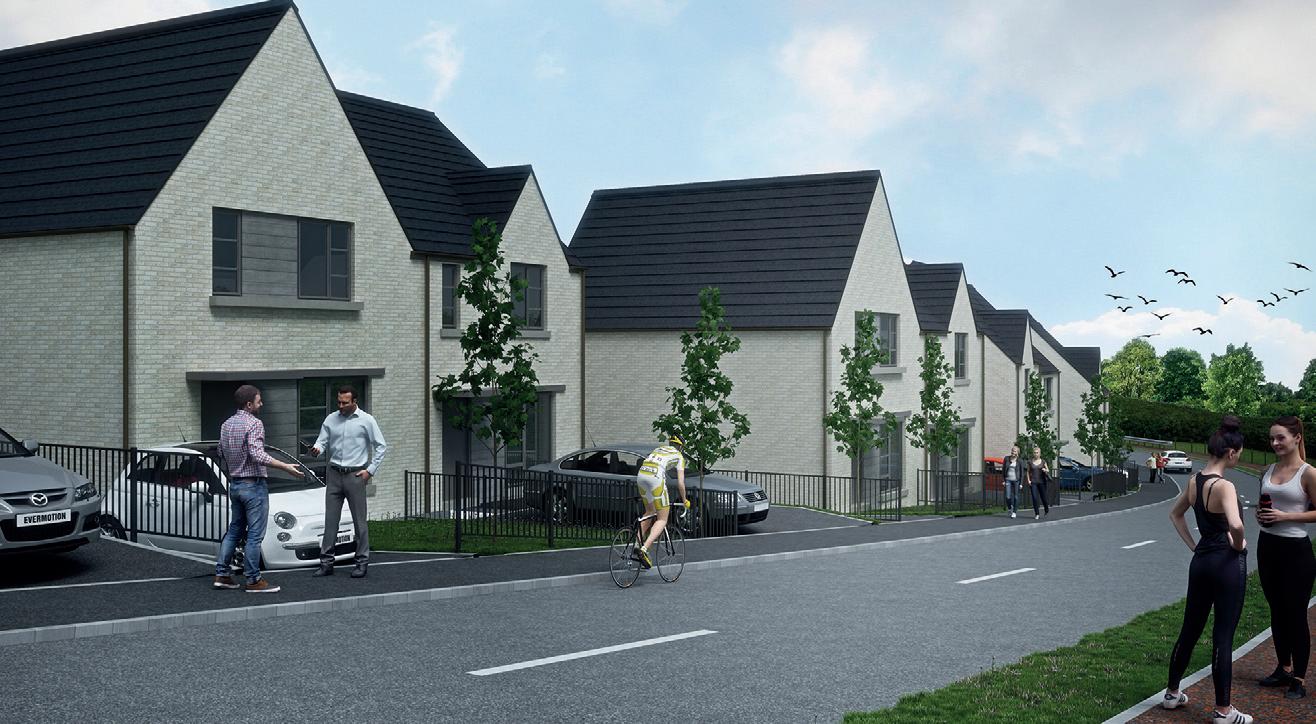
and pedestrian ways. It will also see the delivery of a new high street which will include retail units, a café, gym, and community centre.
Barry Kerr, Apex Director of Development, states: “Commencing construction works on The Cashel is an important milestone in this excellent example of sustainable place shaping. This initial phase will make a significant contribution towards addressing the substantial housing need in the local area. With an important emphasis on remaining carbon conscious and building for the future, supported by the new Northwest Greenway passing alongside the development, we are looking forward to continuing our mission of leading the way in building sustainable communities through the delivery of quality, affordable homes.”
Apex Housing Association
10 Butcher Street
Derry~Londonderry, BT48 6HL
Northern Ireland
T: 028 7130 4800
E: info@apex.org.uk

Average house price in Northern Ireland £175,234
Ranges from £153,244 in Derry City and Strabane to £208,333 in Lisburn and Castlereagh
6,142 residential properties sold during Q4 2022
0.5% quarterly house price decrease in Q4 2022
10.2% house price increase between Q1 2021 and Q4 2022
Average Northern Ireland rent price: £755 per month
Q4 annual rent growth 8.4%
Q4 quarterly rent growth 2.0%
Houses
Average rent £756 per month
Annual rent growth 9.5%
Quarterly rent growth 2.2%
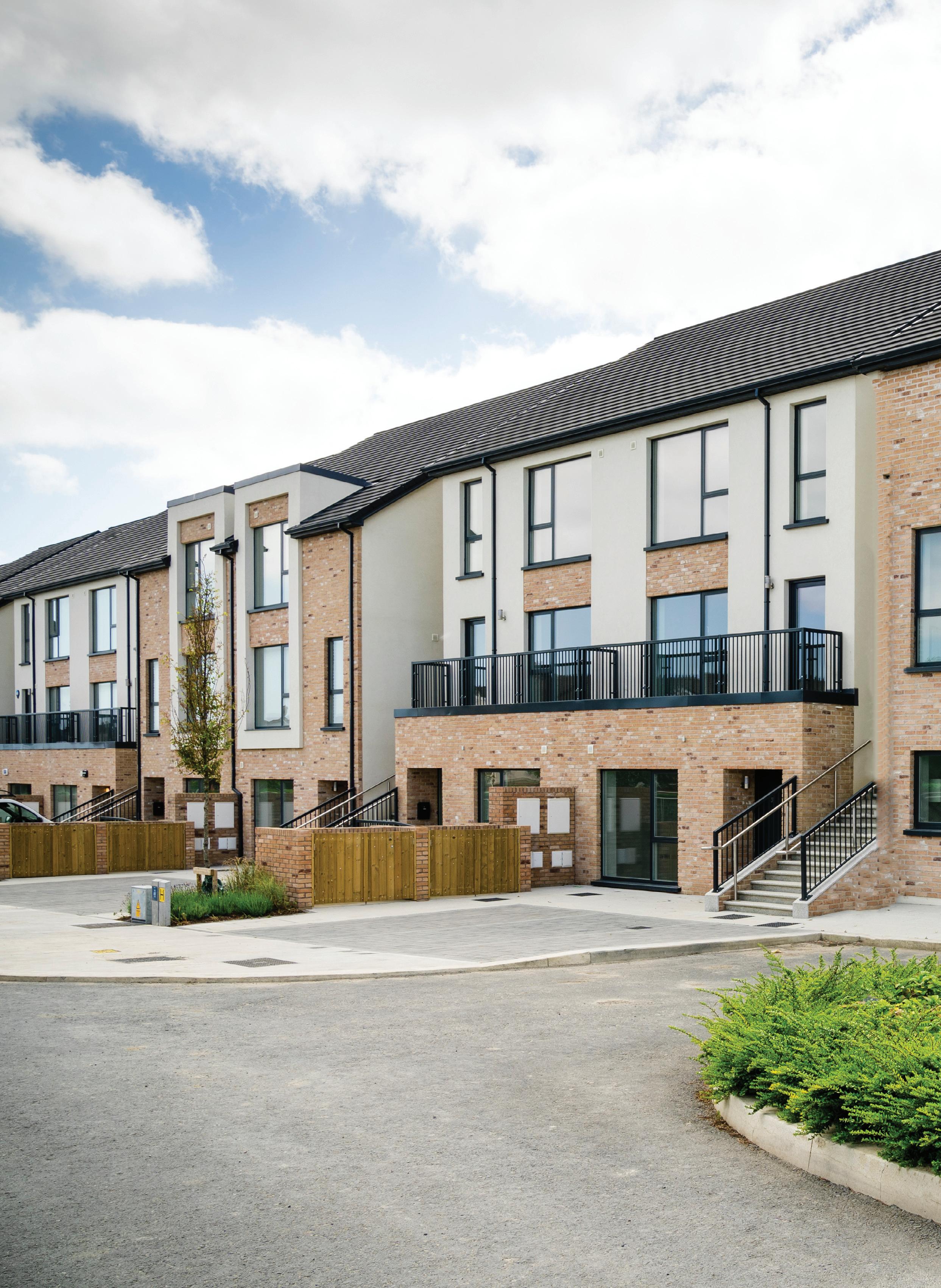
Apartments
Average rent £751 per month
Annual rent growth 6.4%
Quarterly rent growth 1.6%
Source: PropertyPal
In Q4 2022, the volume of housing output increased by 12.3% compared with Q3 2022
2.6% above the pre-Covid-19 pandemic level seen in Q4 2019
59.2% above the 15-year low seen in Q2 2020
Remains 39.3% below the 15-year high seen in Q4 2007
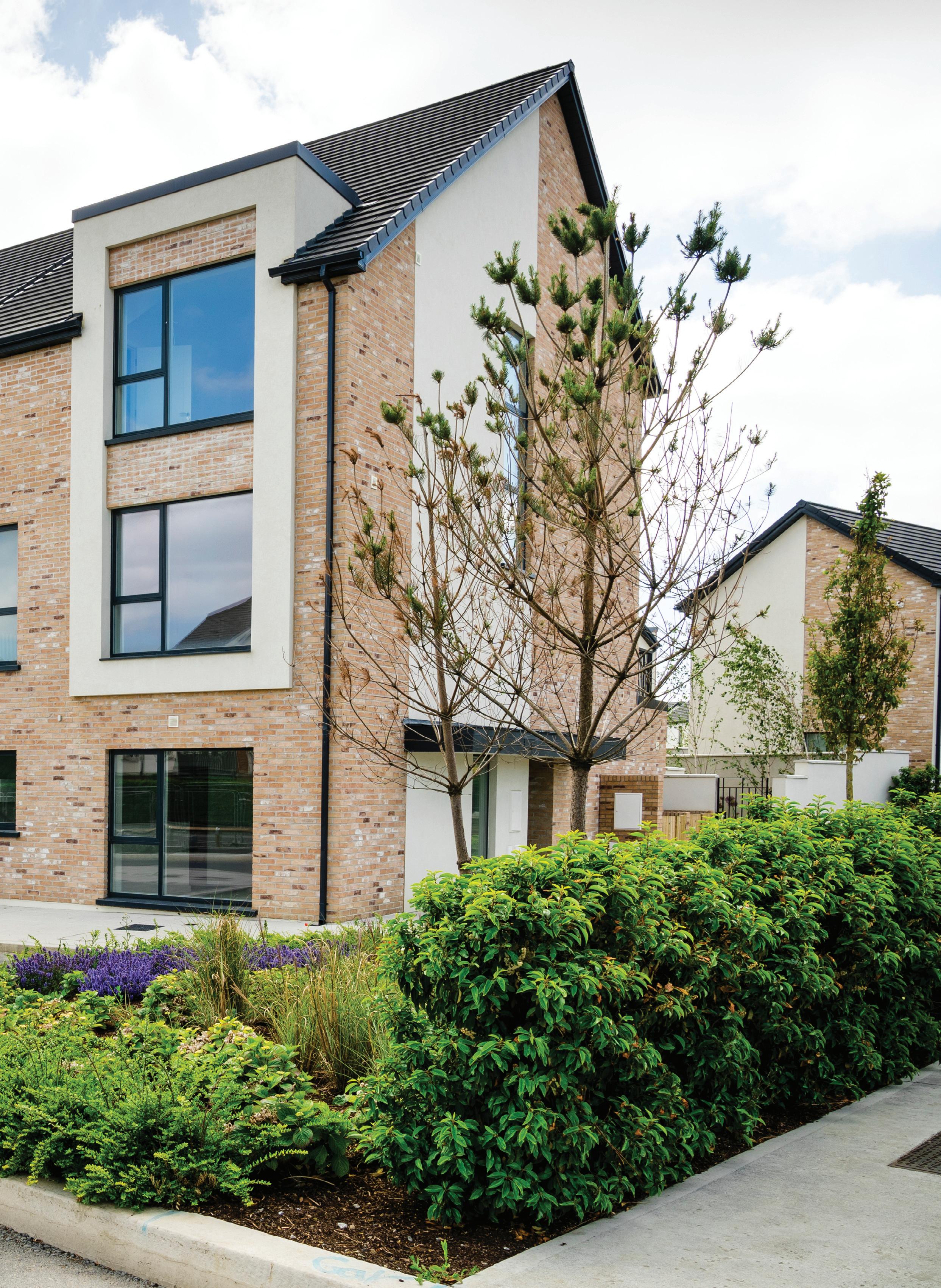
decreased by 1.7% over the year and decreased by 8.3% on a rolling four quarter basis
Annual decrease for the fifth consecutive quarter
In Q4 2022, there were quarterly increases within all housing output sub-components:
• new work housing public (15.3%);
• new work housing private (5.2%);
• repair and maintenance housing public (23.6%); and
• repair and maintenance housing private (12.3%), when compared with the previous quarter.
Source: NISRA
44,519 applicants on housing waiting list
32,371 of applicant households in ‘housing stress’
• This means they have 30 or more points under the social housing selection scheme
5,888 properties allocated by the Northern Ireland Hosing Executive and housing associations to applicants on the waiting list who were not already social sector tenants
• 70.4% of total allocations made in 2022
Source: Department for Communities
3,411 households
presented as homeless to the Northern Ireland Housing Executive in Q4 2022
• Increase of 42 (1.2%) on the same quarter in 2021 (3,369)
1,937 households accepted as full duty applicants in Q4 2022
• Decrease of 230 (10.6%) on the same quarter in 2021 (2,167)
Source: Department for Communities


In April 2023, the Department for Communities (DfC) acquired the vacant Stewart Street site in Belfast’s Market area for housing-led regeneration. In this context, Ciarán Galway visits the area and speaks with Fionntán Hargey, Director of the Market Development Association (MDA), about his community’s longstanding grassroots housing and community regeneration campaigns.
Named after the 14 commercial markets which once surrounded it – St George’s Market being the sole survivor – the Market area of south Belfast is one of the city’s longest established communities. Once an industrial heartland, its streetscape was originally constructed on a grid plan.
With the various industrial ventures which once dotted the area in the early 20th century now consigned to history, the recent conflict compounded the scarring of local geography. The grid system was erased and today, the area has only three points of road access: Stewart Street, Raphael Street, and Eliza Street.
Euphemistically alluded to as “defensive planning”, post-conflict, the consequence for areas such as the Market is continued place-based inequality and socio-spatial segregation from Belfast’s socioeconomic life.

Contained on four sides by East Bridge Street to the north, the Lanyon Place Station railway lines to the east, the Gasworks business park to the south, and Cromac Street (which bisects the area, and was previously intersected by several natural access points from the Market proper) to the west, the Market has been artificially separated from its natural hinterland: the city centre.
“If you look at older maps of the area, it is completely integrated into the city centre. During the redevelopment of Belfast in the late 1960s into the 1970s, three interlocking trends came together: suburbanisation, deindustrialisation, and securitisation of urban planning,” Fionntán Hargey observes.
“The Market, and Belfast as a whole, are not unique in experiencing sociospatial segregation, but it was the combination of those three factors, in the context of the recent conflict, which
exacerbated it beyond the experience of many other cities in the western world.”
In fact, in recent decades, this segregation has been compounded by commercial redevelopment in its surrounding environs. Referencing the Laganside regeneration area which demarcated the land of riverfront to be transformed with £1.2 billion of investment between the mid-1990s and mid-2000s, Hargey suggests that it carefully excluding the surrounding inner-city communities that neighbour the River Lagan.
“This exclusion cut deep within the psyche of these inner-city communities like ours, and the message was ‘keep out, you are not welcome’. Indeed, the only regeneration investment that the Market community observed was in gates, walls, and fences,” the MDA Director reflects.
Established in late 1995, the Market Development Association aims to “promote the wellbeing of all residents living in the Market area of south Belfast”. While the MDA does not employ a dedicated housing officer, almost half of the queries that it receives are related to housing. Discussing housing need withing the Market, the Director explains that an average of 115 families are on the social housing waiting list each year. This figure excludes people experiencing hidden homelessness, because “many local people do not see the point in registering for the waiting list because they do not think they will ever get the required allocation points, are reluctant to linger on the list for years, or do not even understand the system”.
Indeed, in 2018, the MDA community survey which informed We Must Dissent – the MDA’s overarching framework and strategy for community development – found that 86 per cent of Market residents felt that there was not enough decent and affordable housing in the area.
“There is a limited turnover in properties each year. This is exacerbated by the Right to Buy Scheme which is undermining social housing stock,” Hargey notes, elaborating: “The problem that we are observing is that while a social housing unit home may have initially been bought by a tenant as a family home, for myriad reasons that house is eventually sold on and often it is being bought up as an Airbnb or a HMO. Even if someone wanted to buy locally, therefore, they are often being outbid while simultaneously, they cannot get sufficient points to access social housing.”
On the eastern edge of the Market, adjacent to Lanyon Place Station, the Stewart Street brownfield site – a roughly rectangular plot of vacant land with a curving boundary to its south – is one of the foremost initial sights greeting rail passengers entering Belfast city centre.
In 2016, a £55 million high-rise development plan for the site crossed the Rubicon, proposing commercial development within the traditionally

residential footprint of the old commercial markets. The local community met the plan with vociferous opposition, coordinated through the ‘Sunshine not Skyscrapers’ campaign under the wider ‘Save the Market’ umbrella.
“The community’s perspective was that the proposed development epitomised all the bad planning precedents that had been happening within the Market community over the decades. In terms of the MDA’s wider strategies around connectivity and breaking the economic barriers that we are grappling with; it was overdevelopment on steroids.”
In the face of what the Director describes as an “existential threat”, the Market community was bolstered by its “alternative vision for housing”. “We were not just opposing development; rather we had a better alternative for both the community and the wider city; a real community regeneration project rather than just commercial speculation.”
Subsequently, residents fought the commercial plan at the Belfast City Council planning committee and initially lost by 10 votes to four. The plan was then subject to judicial review.
“While the judicial review was going on, the community undertook the Save the Market/Sunshine not Skyscrapers campaign. This involved everything from postering, lobbying, and filmmaking to media engagements and street protests,” Hargey describes.
“Ultimately, we won the High Court judicial review in May 2018. Later that

year, the developer sought to resubmit the planning application to Belfast City Council which then referred it to the Ministerial Advisory Group – an independent expert panel convened by the Department for Communities to assess contentious planning applications.
“In early 2019, the Ministerial Advisory Group came back, rejected the proposal, and vindicated the residents’ opposition on the grounds that it would effectively kill off the Tunnels Project. It was overdevelopment in terms of scale and design on that site. When Covid hit in March 2020, the developer then tried again to push ahead with the plan, and it went back to the Belfast City Council planning committee in November 2020 where, inverting the original decision, it lost 10 votes to four.”
Commenting on this “victory for the Market community”, Sinn Féin MLA and former Minister for Communities, Deirdre Hargey insists: “It was the political support and push that made that happen within Belfast City Council. The campaign was very effective in building up political support, as evidenced by the fact that the committee ultimately opposed it by majority.”
In a latest development, in April 2023, it was announced that DfC had purchased the Stewart Street land for a housing-led regeneration scheme. “That will unlock the tunnels and encourage active travel, while also addressing

“We were not just opposing development; rather we had a better alternative for both the community and the wider city; a real community regeneration project rather than just commercial speculation.”Fionntán Hargey, Director, Market Development Association
housing need, which is prevalent not just in the Market community, but in the city centre as well,” the MDA Director articulates.
While hypothetically, the ground floor units, especially those nearest to the tunnels could be earmarked for commercial use, to complement that project, it is too early to determine how many housing units will be constructed on the Stewart street site. Soon, the MDA will be undertaking that type of engagement with the Market residents, collating their vision for the site.
“In terms of what normally happens, the Department for Communities will defer to the Housing Executive as the housing authority, the Housing Executive will select a housing association to bring forward a housingled scheme on the site,” Deirdre Hargey advises, adding: “We want a level of mixed use on the site to make sure that the development is complementary to the Tunnels Project and that there is good synergy. The designated housing association will bring forward a scheme and it will be down to consultation and engagement as to what the final proposal looks like.”
Discussing the projected configuration of the housing on the site, the Sinn Féin MLA believes that it will be mixed tenure. “Obviously, a portion of the housing will be social and public, but feeding into the sustainability of the community, there is likely to be different types of tenure. The policy of DfC now is to have ‘tenure blind’ accommodation going forward. We still need to address the housing need because we are in a crisis, but it is making sure that it is sustainable, that it fits into its surroundings, and complementary,” she says.
Fundamental to housing-led regeneration plans for the Stewart Street site are the tunnels which run underneath East Bridge Street. The MDA’s Tunnels Project, aimed at reopening the tunnels to facilitate active travel access to Lanyon Place and the wider city centre, as well an associated regeneration was successful in securing funding from the Executive Office and Belfast City Council.
“DfC’s focus is on wider connectivity of regeneration priorities,” Deidre Hargey emphasises. “Consider what Belfast City Council is trying to achieve through its strategic framework for the city, Bolder Vision for Belfast, creating an urban Greenway around the city rather than an inner-city ring route. Bolder Vision for Belfast addresses the community severance of inner-city communities, and how they have been disconnected from the city core and vice versa. We need to overcome that severance that is felt within those neighbourhoods through projects such as the Tunnels Project.
“Key to the Tunnels Project is connectivity; beginning to breakdown the severance of the Market community from the city core. One of the tunnels will be a pedestrianised route that will start to connect all of that up.”
Previously, the ‘Homes Now’ campaign, also under the ‘Save the Market’ umbrella, Market residents had successfully campaigned for housingled development on the northern fringe of the Gasworks site – which borders the Market on its south side.
Running from the River Lagan to the Ormeau Avenue end of the Gasworks, the northern fringe site had traditionally been residential, but during a period of
regeneration was acquired by Belfast City Council and held for the construction of inner-city ring road. However, it remained undeveloped, becoming what is known as a ‘shatter zone’.
Replicated across the inner-city of Belfast, these shatter zones are, according to architect, Mark Hackett, “barriers that were imposed by government onto a community to detach them from the centre”.
Since 2004, the MDA began campaigning for the land to be rezoned for housing. Following the financial crash, from 2015 onwards there was enhanced private sector interest in the site as an investment opportunity for capital development. This provoked the Market community to respond with the Homes Now campaign.
“Today, instead of a proposed total of six houses on that site, there will be 94 units and part of the land developed for community use, including for economic development and job creation. While housing is important, it is also about building sustainable communities. All of this was achieved under the Homes Now campaign banner, with We Must Dissent linking up each of these campaigns,” the MDA Director observes.
Discussing his vision for the future of housing in the Market, Hargey succinctly summarises it in a line: “Homes for all.” Asked to elaborate, the objective, he asserts, is to ensure that “every child being born and growing up in the Market has adequate space to develop and prosper”.
“It is about ensuring dignity for people while building a sustainable community. Housing is a critical part of that. We must ensure that we deliver homes for all and that the Market is a community that continues to develop and evolve, while retaining the spirit of what makes it unique. We are looking to the future in terms of sustainability, and building a neighbourhood that people want to live in and stay in. We want this collective approach to be replicated across the city to build a fairer and more sustainable society.”


Experts in the housing sector discuss challenges for housing organisations in Northern Ireland, including recruitment of young people and adapting skills requirements to meet the needs of tenants in a contemporary age.
How has the skills capacity of organisations had to adapt to meet changing tenant demand?
Justin Cartwright: The pandemic worsened the outlook for recruitment and retention. It also emphasised health challenges; we have to look at what home adaptations are required to ensure that people can live in their homes independently.
Karen Gilmore: The pandemic forced us to think about what really mattered around health and social care. We are now at a re-grouping stage; we have a few green shoots coming through where we are partnering with organisations upon which we are reliant for things like maintenance. We have already looked at the skill sets in our




sector before Covid, and the pandemic probably just accelerated that.
Lawrence Jackson: Before the pandemic, when we had a vacancy, we would get between 30 and 40 applications for the role. If we advertised that job now, we would get 10 applicants if we were lucky. It is not that the job is more complicated, it is that the market is much more competitive, and we are not competing against the organisations we used to for the skills that we need.
Staff are no longer just moving around within the social housing sector; they are moving out of the sector altogether. We now have to approach this problem as though we were any other employer in the market place.
Nuala Murphy: Post-pandemic, the data told us that people are re-thinking how they approach their life and their work. They are being more demanding on what they want to get out of that and one simple demand is around flexibility.
The research also tells us that for women and other groups which are under-represented, the work place was harder to progress in because of systemic inequalities – which exist in any sector – and in any industry. It is not just about a better salary, it is about a better culture. What companies need to get right is their people strategy, their culture, and how people think and feel in the organisation.

It is one thing to recruit new people through graduates and schemes, but if they land in the workplace and the trajectory is not clear, then they leave. It is about the people and culture and understanding what that looks like, committing to progress and focusing on initiatives that you are trying to build for the future.
Ciarán Sheehan: Covid has opened up a huge opportunity for the social housing sector. Board meetings have moved fundamentally online which opens up an international audience and,
subsequently, a much more diverse audience. We can now easily attract people from across the UK and Ireland from other sectors. I do not think everyone quite realises the power we now have to build highly formidable boards.
If you have a recruitment process that is not agile enough to allow someone to lift a mobile phone out of their pocket and apply for a job on a short bus journey home, you will not attract the right people.
How can we convince more young people to consider working in the housing sector?
Justin Cartwright: We need to have more forums for young people to give them the ability to learn and let them have their say. There is a foundation degree due to start in September 2023, and that will be valuable in the future for recruitment because you can do it full-time over two years or part-time over three years. One of the modules is workplace learning, so if you have got existing staff where you think they could do a foundation degree then that is in the pipeline as well.
Karen Gilmore: It took three painful years to get the housing apprenticeship up and running from scratch. I do not


think we do enough for young people and I think the apprenticeship route, with a decent starting salary, can provide a path for young people to come and get a flavour of what it is like to work in the sector.
I think there are good things happening now and it is about what happens next. We can see, demographically, that the age group between 16 and 24 is very under-represented in the housing sector.
Lawrence Jackson: It is partly a generational thing; when we were at school, working in social housing meant working for the Housing Executive. Young people want careers where they can make a difference and that is not sector specific.
We are, frankly, kidding ourselves if we think we will get to a stage where we will have 11-year-olds dreaming of a career in housing; that is not what is going to happen. I think the best we can hope for is for school leavers and teachers to be having a conversation when they are talking to young people about what they want, and for them to at least consider that they could realise their ambitions in housing.
That is a subtly different approach but it is the conversation we are hearing among young people. Young people want to develop their skills and fit in their communities.
Ciarán Sheehan: The next generation of workers do not want long-term careers. No-one goes in aged 17 and wants the same job for 30 years; it just does not work like that anymore.
If you have got a particular aptitude in technology, the challenge for this sector is saying that there is every bit as much an appetite for innovation and technology in social housing as there is
in any other organisation. In fact, there is much less competition so you have a much better chance to flourish and you have a chance to participate in a really engaging project.
Nuala Murphy: Gen Z-aged workers are very much socially driven. They are about social purpose and development of skills and maybe not the longevity of a career. This is where you have the opportunity to present the housing sector as one which is suited to that generation because you have the diversity of the different areas of learning and stretching skills. It is also a sector where there is opportunity for them to be aligning their personal and professional goals.
You can also learn about technology with other sectors of the apprentice schemes they have done, take the good from that and apply it at scale in housing when it comes to recruiting Gen Z and help them thrive in the workplace. If you have your work culture built around diversity and inclusion then that can sell success. In the housing sector, there is a big opportunity for Gen Z recruitment because it offers a socially purposedriven work for the future.
 Ciarán Sheehan, Partner, Clarendon Executive
Nuala Murphy, Director, Diversity Mark
Ciarán Sheehan, Partner, Clarendon Executive
Nuala Murphy, Director, Diversity Mark
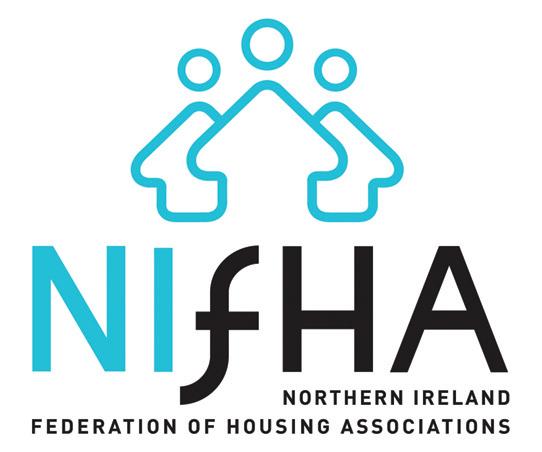

2022/23 was one of the most successful periods for social housing new build in recent years. Housing associations completed 1,449 new houses, and work was commenced on 1,956, exceeding the targets set by the Department for Communities.
The success of the housing associations is even more notable given the context of a challenging time for the construction sector, where materials costs have risen alongside the financial pressures brought on by Covid.
The 20 housing associations in Northern Ireland manage more than 57,000 homes, and directly employ more than 3,300 staff. Seamus Leheny, Chief Executive of the Northern Ireland Federation of Housing Associations, puts this success of the sector down to the determination and passion of the social housing providers: “The challenges faced by housing associations in building new homes are well known, they range from land availability to frustrating planning delays.
But the challenges are not a blockage to our members, which is why we have exceeded targets and maximised the impact of the social housing budget.”
Social housing is funded by the Department for Communities through the Social Housing Development Programme, and housing associations raise private finance to match that funding and ensure that more social housing is delivered each year.
This model helps social housing as a key economic driver, and the support for the construction sector is an important role for associations, as Leheny explains, “Each year, social housing invests more than £360 million on new build, which is a direct benefit for the
construction sector. Housing associations are also committed to improving skills and offering apprenticeship opportunities on their developments, which will help to ensure we have the ability to build more homes to the highest standards in the coming years.
“The standard of new build is something that the sector can be extremely proud of, and when we look at things such as sustainability, more homes are being built to the highest EPC ratings, which will benefit tenants when it comes to things like heating costs.”
Leheny adds: “We are not limiting these standards to new build, and there is ambition to retrofit older properties, with insulation and more efficient heating. There is, however, a significant financial investment to deliver this programme of work, but its benefits are wide ranging. If we are serious about preparing homes for net zero it is something we need action on from local government.”
Fundamentally, the focus of housing associations is on delivering the best homes possible, housing families and reducing the waiting list. One of the concerns the sector has is the potential for reduction in budgets, as Leheny highlights: “We need more homes, particularly social homes. The positive economic and social benefits of social housing are clear. Now is the time to be protecting the investment in social housing, and any cuts would have a devastating impact on social housing, the lives of our tenants and the advancement of a shared settled society in Northern Ireland.”
Seamus Leheny, Chief Executive, NIFHAT: 028 9023 0446
E: sleheny@nifha.org
W: www.nifha.org

General Secretary of Housing Europe, Sorcha Edwards, outlines the top challenges for affordable non-profit housing tenures across Europe and globally.
The first challenge, Edwards believes, is that of building public understanding of cost rental housing, so as to maximise engagement and interest in what she believes is a “potentially very promising” housing model, with her hope that “the European Regional Development Fund may be used to tackle vacancies”.
In Northern Ireland, the intermediate rents policy aims to reduce rent prices to 20 per cent below market value. In the Republic of Ireland, a similar policy, referred to as cost rental, aims to expand the amount of nonprofit social housing.
The differentiation in nomenclature by different organisations, Edwards outlines, can be a source of confusion for the public.
“I think it is a misnomer to use the different terms like social housing, cost rental
housing, general housing, and general interest housing because there is a lot of language interference.
“What could be termed ‘limited-profit cooperative housing’ is actually cost rental; what is termed ‘co-operative housing’ in Switzerland is actually cost rental. All of these models are essentially housing that factors out the profit incentive.”
“In many countries, you have non-profit finance providers who are backing the schemes,” Edwards states. “That could be a public bank, or public revolving funds. In Ireland, we do not have that and there is an urgent need to analyse the scope for nonprofit finance provision in terms of the proportion of subsidies and the proportion of non-profit finance.
“There also might be a difference in terms of the long-term obligation to reinvest any limits on the profits that the entities make. In other countries, there would also be strict auditing and regulation around the reinvestment of any profit.
“The most common issues are the cost of finance, the cost of land, and the pressure coming from unregulated private markets. You also have inflation and interest rates which are making it very difficult, as well as the lack of labour and the cost of construction. There is real pressure to innovate and bring down the price of construction. There is the challenge of competition for the land with private players.”
Edwards emphasises the importance of ensuring that the green agenda being pursued by the EU takes a holistic approach, being acutely aware of the needs of those on lower and middle incomes.
“The European Green Deal, if it is implemented correctly, can help us tackle energy poverty, and can lead to better housing conditions,” Edwards says. However, she warns that: “If the Green Deal is not implemented correctly, it could lead to undesirable and negative consequences. So it is vital that we get the balance right with all of this.”
A further challenge raised by Edwards is the lifting of the break on EU state aid rules, which was implemented over the Covid-19 pandemic. Amid this backdrop, she states the need for “a recognition of the real amount of public finance that is now needed to tackle the crises in housing and the climate” and that “we have clear political space and fiscal space to make that investment which is badly needed”. She also reiterates that spending in these areas must be characterised as an “investment, not a cost”.
“Green taxonomy and the growing impact of environmental and social governance in the financial sector are very important; we have to make sure that the social impact is in line with the constructive work being done on the ground. We cannot allow the agenda on affordable housing to be set by the private sector.”
Emphasising the three key metrics of affordability, availability and sustainability, Edwards again emphasises the need for a balanced policy approach. “We have to go green, but we have to go green in an inclusive fashion,” she states, adding: “We are constantly bringing

“We cannot allow the agenda on affordable housing to be set by the private sector.”
General Secretary of Housing Europe, Sorcha Edwards

together this benchmarking of systems, looking at what tools countries have to tackle the crisis, and how housing systems are equipped to tackle the type of societal challenges that we have.”
Edwards summarises the policy approaches taken by the governments of the Netherlands and Portugal. “The Dutch Government has proposed quite a strong intervention in the private rented market. This is now being debated in Dutch courts. They will step in and reduce rents according to a points system linked to the quality of the homes.
“They are also looking at reducing short-term tenancies; something that was introduced in 2016 intended as a way to increase the speed of supply; it did not work out that way. Now, they are looking back to have permanent tenancies.”
In Portugal, meanwhile, Edwards explains how the Portuguese Government is intervening “to stop the golden visa scheme and to increase the pressure to bring vacant homes back into use”.
She concludes by outlining the challenges of ensuring that government policy is consistent with the needs of low and middle income earners, and how Housing Europe is considering these factors in its research. “We are examining the social impact of having a strong limited profit sector because they can push the issue there. It can be issues like circularity, making sure biodiversity does not suffer from retrofitting, looking at how we can combine approaches, and bringing stock back into use.”
Sorcha Edwards is the General Secretary of Housing Europe, the European Federation of social, affordable, and co-operative housing, a role she has held since 2014. The sector manages 25 million homes and delivers over 200,000 new homes and renovations annually.